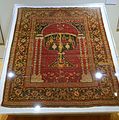Parochet

A parochet (Hebrew: פרוכת, romanized: parôkheth; Yiddish: פרוכת, romanized: paroykhes), meaning "curtain" or "screen",[1] is the curtain that covers the Torah ark (Aron Kodesh) containing the Torah scrolls in a synagogue.
The parochet symbolizes the curtain that covered the Ark of the Covenant, based on Exodus 40:21: "Then he put up the curtain for screening, and screened off the Ark of the Pact—just as יהוה had commanded Moses."[2]
In most synagogues, the parochet which is used all year round is replaced during the High Holy Days with a white one.
The term parochet is used in the Hebrew Bible to describe the curtain that separated the Holy of Holies from the main hall (Hebrew: היכל, romanized: hekhal)[3] of the Temple in Jerusalem. Its use in synagogues is a reference to the centrality of the Temple to Jewish worship.
The Umberto Nahon Museum of Italian Jewish Art in Jerusalem houses the oldest surviving parochet, dating to 1572.[4]
Gallery
[edit]-
Parochet of the Synagoge in Mühlhausen
-
Original parochet from Great Lublin Maharshal's Synagogue from 1926, today in Bielsko-Biała synagogue, Poland
-
Early-17th-century parochet from Cairo, Egypt
-
1698 linen and silk parochet from Venice, Italy
-
Parochet in the Hurva Synagogue in Jerusalem
-
Parochet from 1797, Jewish Museum of Switzerland.
-
Parochet in the Synagogue at 770 Eastern Parkway
References
[edit]- ^ Sonne Isaiah (1962) 'Synagogue' in The Interpreter's dictionary of the Bible vol 4, New York: Abingdon Press pp 476-491
- ^ "Exodus 40:21". www.sefaria.org.
- ^ Stinespring W. F. (1962) 'Temple, Jerusalem' in 'The interpreters Dictionary of the Bible' vol 4 p 536
- ^ Jewish Italian Heritage Lives On in Jerusalem







